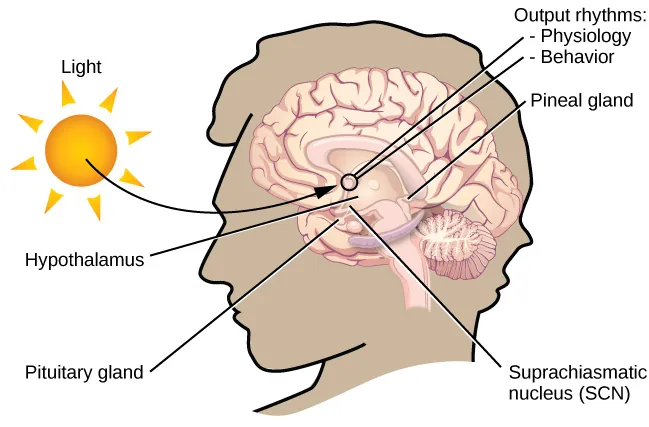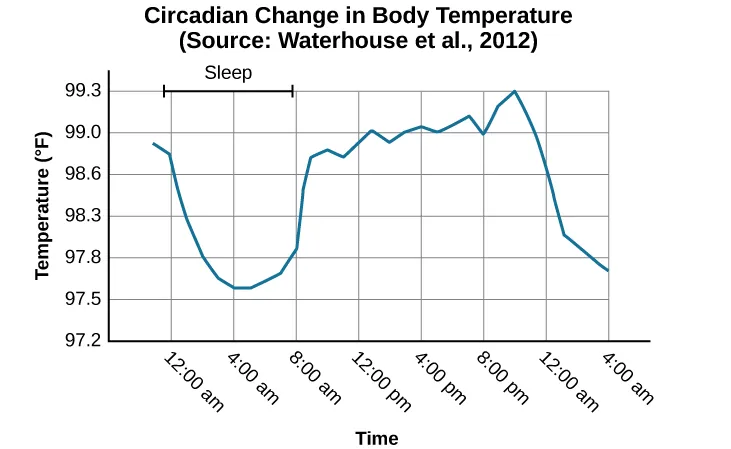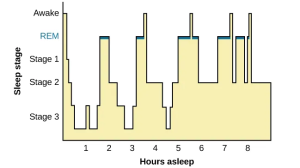Sleep disorders are an important part of neurology examinations as they require a strong knowledge of complex diagnostic studies such as EEG, and also of a multitude of medications. In this chapter, you will learn sleep waveforms using real EEG tracings, and review high-yield treatments for sleep disorders. Test your knowledge at the end with practice questions and flashcards!
Authors: Jody Manners MD, Brian Hanrahan MD
Circadian Rhythms
- Defined as physical, mental, and behavioral changes following roughly a 24-hour cycle, responding primarily to light and darkness in the environment.
- They are endogenous and self-sustained but can be modulated by external cues (zeitgebers).
Table of endogenous and self-sustained zeitgebers
- Ultradian Rhythms occur more frequently than once every 24 hours, such as the stages of sleep, patterns of hormonal release, and appetite regulation.
- Infradian Rhythms are less frequent than 24 hours, often weekly, monthly, or seasonally. Infradian rhythms can be associated with conditions like seasonal affective disorder (SAD) or hormone-related mood disorders.
- The suprachiasmatic nucleus (SCN) of the hypothalamus, the central clock is responsible for synchronizing 24-hour circadian rhythms.
- The axons of light-sensitive neurons in the retina provide information to the SCN, allowing the internal clock to be synchronized with the outside world.
- Melatonin, secreted by the pineal gland, has a key role in sleep onset. Its secretion is inhibited by light and permitted by darkness, signaling the body when it’s night-time.

- Physiological processes influenced by circadian rhythms
- Hormone Release
- Cortisol: Follows a diurnal pattern, peaking in the early morning to help promote alertness and metabolic functions and gradually declining throughout the day.
- Growth Hormone (GH): Significant releases of GH, happen in the early phases of sleep.
- Body Temperature: Core body temperature dropping during the night and rises during the day (see graph below)
- Hormone Release

Phases of Sleep
Wakefulness
- Characterized by alpha frequency activities, sporadic eye movements, and a posteriorly dominant alpha rhythm that attenuates with eye-opening.
NREM sleep
- Stage N1 (5% of total sleep): Associated with an emergence of theta activity, and slow roving eye movements.
- Young adults spend the least amount of time in NREM stage 1 sleep.
- Stage N2 (45-55% of total sleep):
- The stage at which adults spend the most time during normal sleep.
- Characterized by the presence of either sleep spindlesand/or K-complexes with theta range background activity.
- Sleep spindles are thought to be generated by the reticular thalamic nucleus.
- Stage N3 (15-20% of total sleep):
- k.a “deep sleep” or “slow-wave sleep” (no longer called “stage 4 sleep”)
- EEG will show slow-waves and high amplitude delta waves.
- Parasomnias tend to occur during this stage.
REM sleep
- 20-25% of sleep.
- Normally occurs ~90 minutes into sleep.
- Characterized by a desynchronized low voltage, high-frequency background.
- There will be decreased EMG activity (REM atonia).
- Sharply peaked irregular eye movements with lateral rectus spikes (see below) can be seen ON eeg. Note the lack of muscle artifact.

Log in to view the remaining 60-90% of page content!
New here? Choose an account!
Follow on Social Media
NowYouKnow Psych © 2024, all rights reserved
8105 Fayetteville Rd. STE 113-123
Raleigh, NC 27603
* PRITE® is a registered trademark of the American College of Psychiatry (ACP). NowYouKnow Psych™ (NYKP) is a preparatory resource for this and other psychiatry exams but is in no way affiliated with the PRITE® exam or the ACP.
NYKP is in no way affiliated with the American Board of Psychiatry and Neurology (ABPN).
NYKP is a product of NowYouKnowNeuro LLC.
